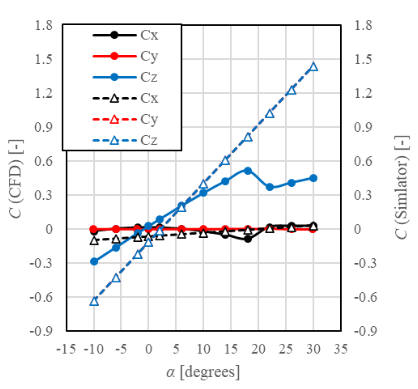Demonstration of airborne wind turbine technology with kites for the general public
JAXA Supercomputer System Annual Report February 2024-January 2025
Report Number: R24EDA201E77
Subject Category: Aeronautical Technology
- Responsible Representative: Kazuyuki Nakakita, Aeronarutical Technology Directorate, Fundamental research unit
- Contact Information: Yoimi Kojima(kojima.yoimi@jaxa.jp)
- Members: Yoimi Kojima, Sho Yokoyama
Abstract
To reproduce the behavior of an aerial wind turbine kite on a flight simulator, we are analyzing the aerodynamic coefficient of the kite and the surrounding flow field during flight using CFD. The kite's characteristic behavior is a figure-eight flight due to self-excited oscillation, and we aim to reproduce this behavior.
Reference URL
N/A
Reasons and benefits of using JAXA Supercomputer System
Unlike airplane wings, kites have complex shapes, and introducing aerodynamic coefficients into the simulator requires large-scale calculations with various values for the angle of attack and angle of sideslip. Therefore, large computational resources and advanced computers are essential, so we are using the JAXA supercomputer.
Achievements of the Year
While research on power generation using kites has progressed with pumping cycles, JAXA is currently studying a method of generating power using figure-of-eight flight by self-excited oscillation. Control is essential for kite power generation, and a high-precision flight simulator is needed to verify the control system at low cost and in a short time, but it has not been possible to reproduce the figure-of-eight flight behavior of kites. Therefore, we investigated the aerodynamic coefficients of a kite using FaSTAR. As a result, we found that there is a difference between the aerodynamic coefficient used in the simulator and the FaSTAR results (Fig. 1 and 2), and we believe that this value affects the behavior during flight. This calculation contributes to the development of airborne wind-powered kites and the clarification of kite behavior.

Fig.1: Relationship between angle of attack and aerodynamic coefficient, comparison of simulator and analysis results

Fig.2: Relationship between sideslip angle and aerodynamic coefficient, comparison of simulator and analysis results
Publications
N/A
Usage of JSS
Computational Information
- Process Parallelization Methods: MPI
- Thread Parallelization Methods: N/A
- Number of Processes: 576
- Elapsed Time per Case: 8 Hour(s)
JSS3 Resources Used
Fraction of Usage in Total Resources*1(%): 0.02
Details
Please refer to System Configuration of JSS3 for the system configuration and major specifications of JSS3.
| System Name | CPU Resources Used(Core x Hours) | Fraction of Usage*2(%) |
|---|---|---|
| TOKI-SORA | 552219.20 | 0.03 |
| TOKI-ST | 2883.97 | 0.00 |
| TOKI-GP | 0.00 | 0.00 |
| TOKI-XM | 0.00 | 0.00 |
| TOKI-LM | 0.00 | 0.00 |
| TOKI-TST | 0.00 | 0.00 |
| TOKI-TGP | 0.00 | 0.00 |
| TOKI-TLM | 0.00 | 0.00 |
| File System Name | Storage Assigned(GiB) | Fraction of Usage*2(%) |
|---|---|---|
| /home | 23.33 | 0.02 |
| /data and /data2 | 35486.67 | 0.17 |
| /ssd | 239.05 | 0.01 |
| Archiver Name | Storage Used(TiB) | Fraction of Usage*2(%) |
|---|---|---|
| J-SPACE | 17.59 | 0.06 |
*1: Fraction of Usage in Total Resources: Weighted average of three resource types (Computing, File System, and Archiver).
*2: Fraction of Usage:Percentage of usage relative to each resource used in one year.
ISV Software Licenses Used
| ISV Software Licenses Used(Hours) | Fraction of Usage*2(%) | |
|---|---|---|
| ISV Software Licenses(Total) | 56.71 | 0.04 |
*2: Fraction of Usage:Percentage of usage relative to each resource used in one year.
JAXA Supercomputer System Annual Report February 2024-January 2025


